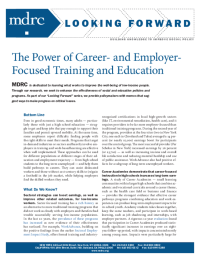The Power of Career- and Employer-Focused Training and Education

Bottom line: Even in good economic times, many adults — particularly those with just a high school education — struggle to get and keep jobs that pay enough to support their families and permit upward mobility. At the same time, some employers report difficulty finding people with the right skills to meet their needs. Programs that target in-demand industries or sectors and heavily involve employers in training and work-based learning are effective when well implemented. These approaches can be used for different populations at different stages of their education and employment trajectory — from high school students to the long-term unemployed — and help them build pathways to careers. They can assist dislocated workers and those without 21st-century skills to (re)gain a foothold in the job market, while helping employers find the skilled workers they need.
What Do We Know?
Sectoral strategies can boost earnings, as well as improve other related outcomes, for low-income workers. Sector-focused training has a rich history as an alternative to more traditional training programs that did not work as closely with employers and therefore had trouble successfully serving low-income populations. In the last 10 years, the prevalence of these programs has increased as new evidence of their effectiveness has surfaced. For example, WorkAdvance, building on the positive findings from the earlier Sectoral Employment Impact Study, offers formal training and industry-recognized certifications in local high-growth sectors (like IT, environmental remediation, health care), and it requires providers to be far more employer-focused than traditional training programs. During the second year of the program, providers at the four sites (two in New York City, one each in Cleveland and Tulsa) averaged a 14 percent (or nearly $2,000) earnings boost for participants over the control group. The most successful provider (Per Scholas in New York) increased earnings by 26 percent (or $3,700) — as well as increasing income and overall life satisfaction and reducing material hardship and use of public assistance. WorkAdvance also had positive effects for a subgroup of long-term unemployed workers.
Career Academies demonstrate that career-focused instruction in high schools increases long-term earnings. A study of Career Academies — small learning communities within larger high schools that combine academic and vocational curricula around a career theme, such as the health care field or business and finance — provides the strongest evidence that effective career pathways programs combining education and work experience can produce long-term employment impacts for in-school youth. Academy students take classes together, keep the same teachers, and participate in work-based learning, such as job shadowing and internships, with employer partners. A rigorous 12-year evaluation found that participation in Career Academies produced statistically significant increases in earnings over an eight-year follow-up period, with impacts concentrated mostly among young men. Impacts were particularly large for students deemed most at risk of dropping out. Research on Career Academies also demonstrates the value of engaging employers in work-based learning, mentoring, career awareness programs, and advisement on curriculum and labor market trends.
A career approach to high school equivalency (HSE) instruction can boost pass rates and subsequent college enrollment. The Bridge to College and Careers Program at LaGuardia Community College in New York City offers a sector-focused approach, supporting students in their understanding of, application to, and persistence in specific college-level programs in science, health, and business. In its evaluation of the program, MDRC found that participating students were much more likely to pass the HSE exam, enroll in college, and persist into the second semester. MDRC is also evaluating a similar program at Northeast Wisconsin Technical College, the results of which will be available in 2017.
Integrating basic education with occupational skills training boosts academic outcomes. Washington State’s Integrated Basic Education and Skills Training (I-BEST) aspires to help community college students gain proficiency in English and math and also prepare them for specific career fields, such as nursing, early childhood education, and automotive repair. What is unusual about I-BEST is that the English and math instruction is integrated into the occupational curriculum, rather than the more conventional approach of teaching the subjects separately. For example, students in nursing programs attend English classes that emphasize medical terminology and writing used in health care settings. Researchers found that I-BEST students had higher persistence rates, earned more credits toward a college credential, earned more occupational certificates, and showed greater improvement on tests. Programs like I-BEST can serve as a “bridge” to sectoral training programs that often require higher levels of skills to participate.
Much innovation is happening in sector-based strategies that deserves study. For example, IBM, the New York City Department of Education, and the City University of New York developed Pathways in Technology Early College High School (P-TECH), a six-year high school in Brooklyn where students participate in work-based learning experiences at IBM, earn college credits while in school, and graduate in six years with both a high school diploma and a free associate’s degree from CUNY. Students are also guaranteed to be first in line for entry-level jobs at IBM. In California, the Chancellor’s Office of Community Colleges is piloting the New World of Work program, which connects community colleges and regional business organizations to develop training programs that impart 21st-century skills to workers.
What Are the Common Lessons Across Successful Programs?
Involving employers matters. Years of focusing on job seekers’ needs in employment and training programs, with limited consideration of employers’ needs or the climate of particular industries and labor markets, has led to generally modest effects, even among successful programs. Workforce systems and career pathways models that target high-demand sectors and emphasize real partnerships with employers are promising improvements.
Programs that target different populations share common design elements. Successful strategies combine education (academic and technical) with work experience in particular industries or occupations; align curricula and program requirements across different education systems (secondary, postsecondary, and adult education); provide on-ramps that help underprepared individuals advance quickly and effectively toward postsecondary learning and credentials; and offer counseling that promotes better choices and persistence. As research has shown, effective programs can improve outcomes for a wide range of people, particularly disadvantaged young people, including young men of color; adults without high school credentials and with low skills; and long-term unemployed workers.
Alignment across systems requires new organizational approaches. Alignment and collaboration across systems and institutions, whether K-12 and postsecondary schools, workforce development programs, or employers, does not occur easily or automatically. In many communities, special intermediary (or “backbone”) organizations convene key stakeholders, build consensus, and manage and monitor career pathways efforts across systems.
Work-based learning offers multiple benefits. Work-based learning is an effective method for teaching skills that are valued in the labor market and a powerful incentive to keep individuals engaged. For younger participants, work-based learning experiences are opportunities to explore careers while building work readiness. For older individuals who need to earn income, paid internships and jobs can be part of an incentive structure that encourages them to strive, persist, and succeed.
For more information, contact Richard Hendra, 212-340-8623, Richard.Hendra@mdrc.org
* * *
This policy memo was supported by the Annie E. Casey Foundation.







